DIGITAL MARKETING
Scaling Smart: How to Evolve Your Localization Strategy with Your Product

Detailed localization services give companies a significant advantage in crowded markets by delivering experiences tailored to cultural distinctions. Executing their localization strategy enhances their financial results by improving conversion rates and accelerating market entry.
Achieving success requires more than simply translating content. Effective localization requires adaptable systems that manage expansion seamlessly as their essential foundation. Measurable goals and clear KPIs enable stakeholders’ organization and allow teams to monitor their progress.
This article teaches product managers how to create a flexible localization strategy that expands alongside their product. It also teaches readers practical methods for expanding their localization efforts through process evaluation, team assembly, tool selection, and result tracking.
Current State of Your Localization Process
Product managers should thoroughly examine their existing localization processes to pinpoint strengths and improvement opportunities before expanding their localization approach. A systematic evaluation will establish an infrastructure for environmentally friendly growth while preserving quality standards throughout international markets.
1. Key components to assess
The effectiveness of localization services depends on multiple integrated factors. Product managers must examine their target markets and languages to learn about cultural priorities and purchasing behaviors. Website traffic metrics, customer satisfaction scores, and conversion rates, along with clear key performance indicators (KPIs), provide reliable success measurement methods.
Team structure makes processes more efficient. Successful localization requires four key groups: The successful localization process requires four fundamental teams, including software developers, project managers, content creators/translators, and quality assurance specialists. Centralizing localization efforts between marketing departments, web developers, product teams, and customer support staff enables significant cost reduction and quality enhancement.
2. Common bottlenecks to address
Recurring challenges frequently impede organizations’ localization workflows. Isolated teams produce significant bottlenecks because they lack adequate communication channels between various process stages. One primary cause of inefficiency occurs when developers, designers, and translators operate with different tools that fail to synchronize, causing scattered workflows and project delays.
Manual tasks create another major obstacle. Teams don’t deal very well with:
- Repetitive file preparation and content uploads.
- Time-consuming screenshot management for context.
- Inefficient review and validation processes.
When software contains hard-coded strings, technical constraints create delays in the workflow. Developers face increased complexity in localization because they need to update every text instance manually in the code.
Automation should be used to streamline organizational operations wherever applicable since repetitive tasks such as file handling and quality checks benefit significantly from this approach. A central system for managing content eliminates version control problems while maintaining uniformity throughout every localized material.
By systematically working through these components, product managers can establish an efficient localization process that facilitates their global expansion objectives. The strategy deployed ensures top-notch quality standards in every target market.
Building Your Scalable Foundation
Building a strong foundation is essential for scaling localization operations throughout worldwide markets. Product managers can establish flexible frameworks by building effective teams and selecting appropriate tools to handle increasing demands.
1. Setting up the right team structure
A centralized team structure with defined roles for everyone is essential for the proper localization strategy. The most effective teams include both internal specialists and external localization service providers. Your team needs to include a visionary leader, project managers, translators, localization engineers, and quality assurance specialists—defined roles for each team member to prevent delays in workflow processes.
2. Choosing localization tools that grow with you
Scalable localization depends on having the right technology stack as its essential component. Your Translation Management System (TMS) serves as your main coordination center and includes critical capabilities.
- Automated workflows that simplify task assignments.
- Quality assurance checks across 22 languages.
- Integration with Figma and development platforms.
- Cloud-based translation memory that maintains consistency.
3. Creating flexible workflows
Agile workflows enable teams to adjust their methods rapidly to match product development changes. Teams must embrace continuous localization approaches because traditional waterfall methods no longer suit modern development needs. This approach lets translation happen alongside development, enabling products to reach markets faster with simultaneous releases.
Teams can boost efficiency when they:
- Set up automated processes for routine tasks.
- Build clear documentation and guidelines.
- Create regular feedback loops with stakeholders.
Quality workflows handle increased volume smoothly. Teams that blend machine translation capabilities with human expertise maintain high standards during scaling operations. A unified source of truth alongside version control helps maintain content consistency during growth.
The combination of smart team-building practices, appropriate tool choices, and adaptable workflows establishes a robust localization foundation that enables growth. This approach enables organizations to preserve quality standards across multiple markets during their growth period.
Aligning Localization with Product Growth
The success of products in global markets requires synchronizing localization strategies with the products’ development phases. Studies demonstrate that 76% of consumers choose products with information available in their native language, making localization essential to entering new markets successfully.
1. Mapping localization needs to product stages.
Product managers must maintain revenue records from non-English-speaking markets. This helps them set their localization priorities. Applying this information will ensure that resources are effectively spread throughout all stages of product development.
As products expand, they must respond to different cultural norms. Localization means more than just translation. It covers:
- Cultural adaptation of content and functionality.
- Market-specific user interface modifications.
- Regional compliance requirements.
- Local news and content relevance.
2. Prioritizing markets based on product data
Market prioritization achieves optimal results through the support of essential metrics and market indicators. Product managers need to look at:
- Annual growth forecasts for individual countries.
- Current revenue percentage from each target market.
- Competitive landscape analysis in potential markets.
Thorough market research enables organizations to gain insights into cultural preferences and consumer patterns within their target regions. Understanding individual user preferences empowers the development of tailored experiences that draw users in and promote product adoption.
Content needs to reflect the cultural aspects of local users. Investing in culturally aware localization helps companies establish trust while preventing misunderstandings. Feedback from local users helps improve localized products through iterative testing and refinement.
Quality becomes vital during market expansion. Effective localization requires organizations to implement robust quality control checkpoints during all phases. The quality control checkpoints throughout localization processes involve linguistic review, functional testing, and user acceptance testing. Translators rely on detailed localization kits to achieve accurate meaning transmission because of the contextual information they provide.
Product managers establish adaptable strategies that boost worldwide growth through synchronized localization efforts at different product stages and data-driven market decisions.
Measuring Success and Scaling Impact
Product managers require appropriate metrics to enhance the effectiveness of their localization initiatives. Recent studies reveal that 96% of businesses experience positive returns through localization investments, while 65% achieve triple or more ROI.
1. Essential metrics to track
Product managers can evaluate their localization effectiveness by using these specific performance indicators.
- Translation Quality: Close monitoring of quality rates and error frequencies ensures high-standard maintenance. Product managers need to use standardized evaluation tools, such as MQM, for objective quality assessments.
- Turnaround Time: The duration of project completion from beginning to end reveals essential insights. The provided information allows teams to identify workflow disruptions and refine their processes.
- Cost Efficiency: Analyzing spending patterns based on language and market helps supply chain managers predict accurate resource requirements. Ideal resource management requires teams to measure cost efficiency by word tracking to remain within budget constraints.
- Customer Satisfaction: CSAT surveys provide insights into the reactions of target audiences toward localized products. Their feedback directly shapes future localization strategies.
2. Using data to guide expansion
The scaling success requires ongoing analysis and monitoring of performance data. Product managers can use advanced analytics to:
- Optimize Costs: Analyzing words processed by the project and provider enables the identification of cost-saving opportunities.
- Improve Workflows: The use of delivery times and average job duration metrics aids organizations in streamlining their processes.
- Control Quality: Performance differences across language pairs are revealed by Language Quality Assessment scores in each category.
Product managers find clear starting points through Google Analytics reports and attribution modeling. They can calculate value by comparing the initial investment with the revenue from localized products.
Numbers reveal powerful narratives that influence organizational results. Self-service reporting tools enable companies to identify market trends that inform their expansion strategies and resource allocation decisions.
Localization services maintain their strength while handling greater volume. This process’s scalable nature ensures consistent output regardless of project size. Product managers need to implement robust tracking systems that closely monitor all essential metrics.
Conclusion
Successful global expansion requires more than essential translation services. Businesses need to deliver strategic localization services that adapt alongside their product development. When product managers analyze their existing procedures while developing scalable infrastructure, they align localization efforts with product stages to drive lasting international success for their companies.
The localization trip requires evidence-based decision-making to ensure success. Process optimization for teams can be achieved by monitoring essential metrics such as translation quality, turnaround time, and customer satisfaction. This method enables businesses to uphold superior quality standards across all marketplaces.
Successful localization scaling demands meticulous planning, an appropriate team framework, and adaptable tools that evolve to match business requirements. Businesses implementing this complete approach see impressive returns, with 96% experiencing positive ROI from localization investments. To achieve success in global markets, product managers must evaluate their localization strategy, measure its outcomes, and adjust their techniques according to performance data.
DIGITAL MARKETING
Kick Chat Logs: Transforming Digital Conversations with Transparency and Insight

In today’s rapidly evolving digital landscape, online communities thrive on connection, authenticity, and accountability. One of the platforms leading this transformation is Kick, a fast-growing live-streaming and community hub. At the heart of its growth lies a simple but powerful tool—Kick Chat Logs. These logs do more than record messages; they create a culture of transparency, moderation, and meaningful engagement that sets Kick apart from traditional platforms.
This article explores what Kick Chat Logs are, how they work, and why they represent the future of online community management and user empowerment.
What Are Kick Chat Logs?
Kick Chat Logs are records of conversations happening across Kick streams and chats. They provide a secure, chronological archive of messages exchanged in live chats, helping both creators and community managers track interactions, maintain standards, and analyze engagement.
In an age where online harassment, misinformation, and anonymity can erode trust, Kick Chat Logs offer a solution rooted in accountability. By capturing every exchange, they enable fair moderation and ensure everyone plays by the same rules.
A Philosophy of Transparency and Responsibility
At the heart of Kick Chat Logs is a commitment to making online spaces safer and more constructive. This philosophy emphasizes:
-
User Empowerment: Giving creators and moderators the tools to review, report, or address problematic behavior quickly.
-
Community Trust: Building confidence among users who know their interactions are stored securely and fairly.
-
Data Integrity: Maintaining accurate records to prevent disputes, misinformation, or manipulation.
Kick Chat Logs reflect the growing recognition that digital platforms are not isolated—they’re communities where fairness and transparency must thrive.
Bridging User Experience with Platform Integrity
What makes Kick Chat Logs especially noteworthy is their ability to merge user convenience with platform accountability. Examples include:
-
Moderation Tools: Allowing moderators to quickly access logs to resolve disputes or enforce rules.
-
Analytics for Creators: Helping streamers understand which content sparks the most engagement.
-
Safety Features: Tracking harmful or abusive behavior to keep communities welcoming.
By embedding these capabilities, Kick Chat Logs illustrate how platforms can create a virtuous cycle of trust—where users feel secure, and secure users create healthier communities.
Influence in the Digital Age
As one of the newest players in the streaming space, Kick understands that social platforms succeed or fail based on user trust. By embracing features like chat logs, the platform signals its dedication to responsible growth.
This savvy approach enables Kick to:
-
Reach Broader Audiences: Many creators now prefer platforms with transparent moderation systems.
-
Engage Younger Users: Gen Z values authenticity and accountability in online spaces.
-
Inspire Other Platforms: Kick Chat Logs set a precedent other apps may follow to improve user experiences.
A Model for the Next Generation of Platforms
Kick Chat Logs reflect a broader shift in online engagement. Users no longer want to participate in communities where bad behavior goes unchecked or where decisions feel arbitrary. Instead, they’re seeking spaces that embody:
-
Authenticity: Real conversations backed by reliable records.
-
Fairness: Equal treatment of all users regardless of status.
-
Safety: Features that minimize harassment and toxicity.
By championing these principles, Kick has positioned itself as both an innovator and a role model, guiding the next wave of digital platforms toward greater responsibility.
Challenges and Opportunities
Like any platform navigating a complex digital environment, Kick Chat Logs face challenges:
-
Privacy Concerns: Balancing user safety with data protection.
-
Data Volume: Managing massive amounts of chat data efficiently.
-
User Education: Ensuring people understand how chat logs work and why they matter.
Yet these challenges also present opportunities for innovation. By investing in encryption, machine learning, and intuitive user dashboards, Kick can enhance its chat logs to deliver even more value.
Kick Chat Logs and Community Growth
Beyond moderation, Kick Chat Logs also play a role in helping creators grow their communities. With clear insights into what drives engagement, streamers can fine-tune their content strategies, schedule streams for peak activity times, and reward loyal community members.
This data-driven approach turns Kick Chat Logs into more than just a compliance tool—they become a growth engine for creators and an engagement enhancer for communities.
Looking Ahead
As Kick continues to expand globally, Kick Chat Logs are poised to become a cornerstone of its long-term success. In a world where consumers and creators demand accountability, transparency, and safety, Kick’s investment in chat logs sets it apart from the competition.
Future developments may include:
-
Advanced AI Moderation: Using AI to flag potential violations in real time.
-
Creator Dashboards: Giving streamers advanced analytics from their chat logs.
-
User Controls: Allowing users to download or manage their chat history for better transparency.
These innovations will strengthen the bond between platform, creator, and audience—showing that technology can enhance trust rather than erode it.
Conclusion
Kick Chat Logs embody the evolution of online community management. They combine transparency, accountability, and actionable insights, offering a model for other platforms to follow. In doing so, they elevate Kick from just another streaming service to a community-centric platform where safety and engagement go hand in hand.
As the digital world continues to evolve, Kick Chat Logs stand as proof that responsible innovation can create spaces where everyone thrives. By embedding trust into the very structure of its platform, Kick sets a new standard for how communities can grow, interact, and succeed online.
DIGITAL MARKETING
Enhancing Pin Discoverability with AI-Generated Pinterest Descriptions

Pinterest has evolved into a powerful visual search engine that influences how users discover products, content, and ideas. While compelling visuals are essential, it is the descriptions that often determine whether a pin gets discovered, saved, or clicked. Optimized descriptions help the Pinterest algorithm categorize pins more accurately and match them to user search intent.
According to Sprout Social, Pinterest saw a 23.2 percent year-over-year growth in its user base as of January 2024, making it one of the fastest-growing social platforms. Additionally, data shows that 83 percent of weekly Pinterest users have made a purchase based on content from brands, underscoring the platform’s ability to drive high-intent conversions.
As more users rely on Pinterest to plan purchases and gather information, the importance of well-written, keyword-rich descriptions has grown. However, writing these manually for dozens or hundreds of pins can be time-consuming. AI-powered Pinterest description generator solves this by automating the creation of search-optimized descriptions that align with trending keywords and user behavior patterns.
Why Pinterest Descriptions Matter
Pinterest functions as a search-driven platform, meaning that text-based descriptions impact rankings as much as images do. Well-crafted descriptions serve multiple critical functions:
- Boosting search visibility – Keywords enhance pin ranking in Pinterest’s algorithm, making content more discoverable.
- Enhancing engagement – Informative and structured descriptions encourage saves, repins, and clicks, leading to greater user interaction.
- Influencing conversion rates – Strategic descriptions guide users toward taking actions like visiting a website or making a purchase.
Pinterest’s algorithm prioritizes optimized descriptions, meaning the absence of well-structured text could result in a missed opportunity for engagement and conversions.
The Role of AI in Pinterest Description Optimization
AI-powered tools leverage machine learning to analyze Pinterest search trends and generate optimized descriptions based on what users are actively searching for. These tools focus on:
- Keyword Analysis – AI identifies high-performing keywords, helping pins rank better.
- Audience Behavior Insights – AI examines user search intent, ensuring descriptions align with user expectations.
- Contextual Relevance – AI-generated descriptions remain aligned with pin content, maintaining accuracy and readability.
How AI Enhances Pinterest Descriptions
AI tools streamline the description-writing process, ensuring every pin is optimized for maximum engagement and visibility. Key benefits include:
- Efficiency – AI automates content creation, generating descriptions instantly.
- SEO Optimization – AI suggests trending keywords for better search ranking.
- Consistency – AI ensures brand messaging stays uniform across multiple pins.
- Higher Engagement – AI structures descriptions to maximize readability and interaction.
How AI-Powered Pinterest Description Generators Work
AI-driven Pinterest description generators follow a structured process to ensure optimized, user-friendly descriptions:
- Input pin details – Users provide keywords, themes, and relevant context for AI analysis.
- AI processing – The tool examines search trends and user engagement data to generate optimized descriptions.
- Customization and optimization – Users refine AI-generated descriptions to align with their branding.
- Implementation – Finalized descriptions are added to pins, improving search visibility and engagement.
Optimizing Pins with AI-Generated Descriptions
Pinterest is a competitive platform where visibility depends on more than just eye-catching images. AI-generated Pinterest descriptions provide a strategic advantage by automating keyword-rich, engaging content that enhances search ranking and audience interaction. These descriptions ensure better discoverability, improved engagement, and higher conversion rates, making AI an essential tool for modern Pinterest optimization.
- Prioritize Relevant Keywords: Strategic keyword selection ensures pins rank higher in searches. AI tools recommend trending keywords, increasing a pin’s visibility.
- Write Clear, Engaging Descriptions: Structured descriptions improve readability and encourage user interaction. AI-generated text ensures descriptions remain concise yet effective.
- Maintain a Consistent Brand Voice: Uniform messaging across Pinterest boards strengthens brand recognition. AI-generated descriptions help maintain a cohesive brand identity.
- Analyze Pin Performance Metrics: Tracking engagement allows users to refine descriptions over time. AI-powered analytics offer insights to optimize pin performance.
AI’s Impact on Pinterest Strategy
AI-driven descriptions streamline content creation while improving discoverability. Research indicates that pins with AI-optimized descriptions see 60% higher engagement, leading to more saves and repins.
Businesses and content creators leveraging AI experience measurable improvements in:
- More efficient workflows – Automated descriptions reduce manual workload, saving valuable time.
- Better search rankings – AI-generated descriptions enhance Pinterest SEO, ensuring higher visibility.
- Increased user engagement – Well-optimized descriptions encourage more clicks, saves, and conversions.
Real-World Application of AI in Pinterest Marketing
Many industries successfully leverage AI-generated descriptions to boost organic reach and engagement. Here’s how AI impacts different sectors:
- E-commerce – AI-generated descriptions improve product pin rankings, increasing sales conversions.
- Content creators – Bloggers use AI to optimize Pinterest descriptions, driving more traffic to their websites.
- Travel and lifestyle brands – AI-powered descriptions help capture audience interest, increasing shares and engagement.
Future of AI-Driven Pinterest Optimization
AI is redefining Pinterest marketing, offering advanced automation solutions for effortless content creation. With continued improvements, AI-generated descriptions will:
- Enhance personalization – AI will tailor descriptions based on individual user preferences.
- Integrate voice recognition – Users may soon generate optimized descriptions via voice commands.
- Predict engagement trends – AI tools will forecast audience behavior, enabling strategic content adjustments.
Conclusion
AI-generated Pinterest descriptions revolutionize pin optimization, helping users create keyword-rich, engaging descriptions without manual effort. Using tools like a Pinterest description generator, content creators can increase pin discoverability, enhance engagement, and improve search rankings effortlessly.
As Pinterest continues to evolve as a search-driven platform, leveraging AI ensures pins remain competitive in search results while maximizing audience reach.
Start optimizing your pins today with AI-powered descriptions and unlock new growth opportunities!
DIGITAL MARKETING
Design Job Recruitment Clips Quickly With AI Video Maker

Today, more than ever, visual storytelling is essential when it comes to hiring. For a company, it has become more challenging to stand out from the crowd, especially when there are so many job listings for the same role. Static job descriptions are no longer enough. Content that, at a glance, will spark interest and build trust is what you need.
A boring post sinks, but a punchy, catchy recruitment video can halt the scroll. It brings potential applicants into your story before they even read a word of text.
With CapCut Web, recruiters who want to cut through the noise are supplied with a modern, easy-to-use solution. You don’t need professional editing skills to create high-impact, fast and creative recruitment content with its powerful AI video maker.
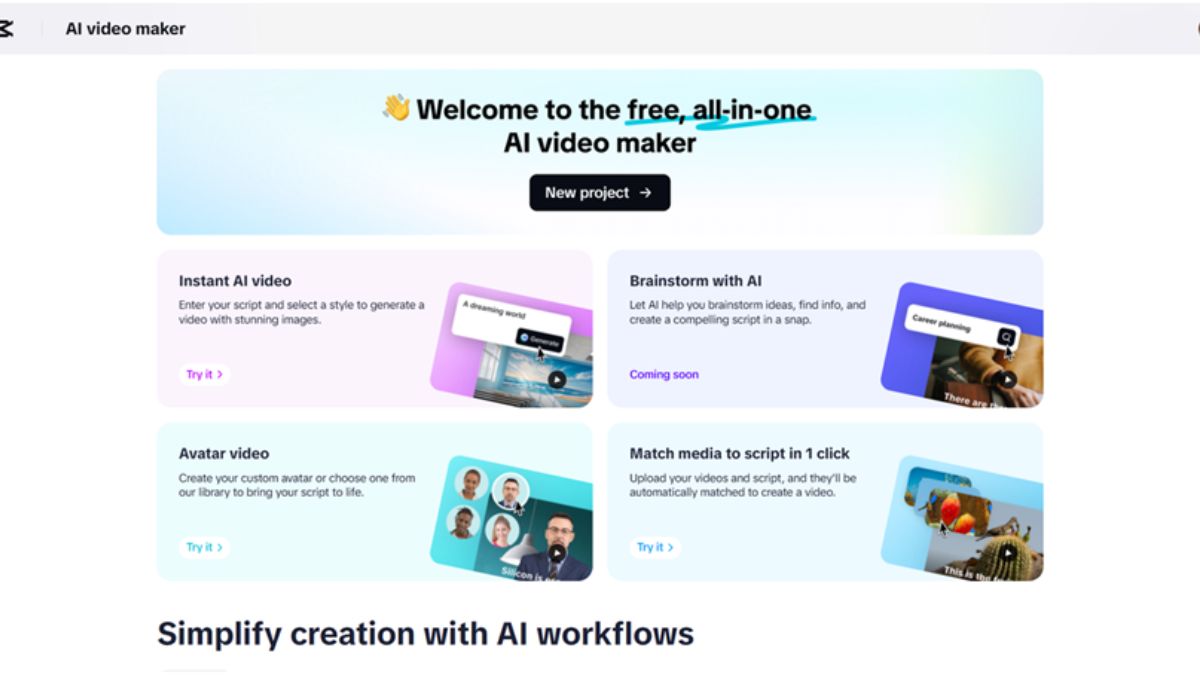
Why Recruitment Needs Creative Video
The video makes a job opportunity come alive. It helps the candidates understand not only the position but also the people, values and atmosphere behind the offer.
What job seekers do with video is different. No longer do we waste time reading a page of qualifications; instead, they watch a 60-second clip and can get a sense of the company culture. A good video can help communicate passion, energy and mission in a way no words can.
You tell a story beyond a list of benefits. And you show diversity, inclusion, creativity and team spirit — which can get lost in the text. Today, with platforms like LinkedIn and TikTok, delivering a story through a video is your competitive edge.
Core Elements of a High-Impact Recruitment Video
Start with your company’s mission and vision. Represents what it is going to be like working with potential candidates and what the goals are that everyone is working towards. Next, place testimonials from current employees. Honest, unscripted messages from real people make them authentic.
Showcase the office environment, remote setup, or unique perks. Whether it’s creating happy work spaces, flexible schedules, or team events, these small touches will make a big difference. Together, they make candidates see themselves as being part of your team.
How to Design Job Recruitment Clips Quickly With CapCut Web’s AI Video Maker
Step 1: Create Your Script
Start with scripting your video. In CapCut Web’s “Script” feature, type your topic and key points. Hit “Create” to generate a custom script that fits your recruitment goal.
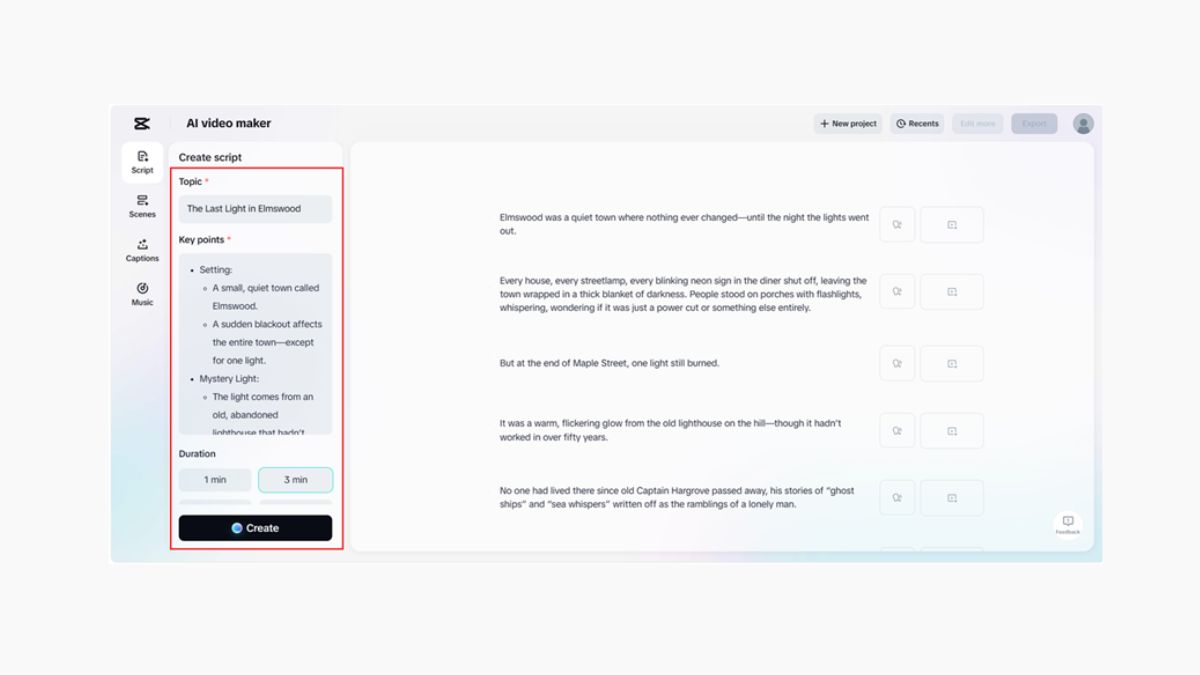
Step 2: Edit Your Recruitment Clip
Next, head to the “Scenes” section. Add voiceover to each part of your script. You can choose from a wide selection of AI avatars or generate your own to represent your brand visually. If you prefer only a voice overlay, go to the “Voice” section, pick your favorite tone, and apply it to all scenes. Add captions by clicking the “Captions” button and select a style that suits your brand identity. Enhance your video using CapCut Web’s music library with creative and royalty-free tracks.
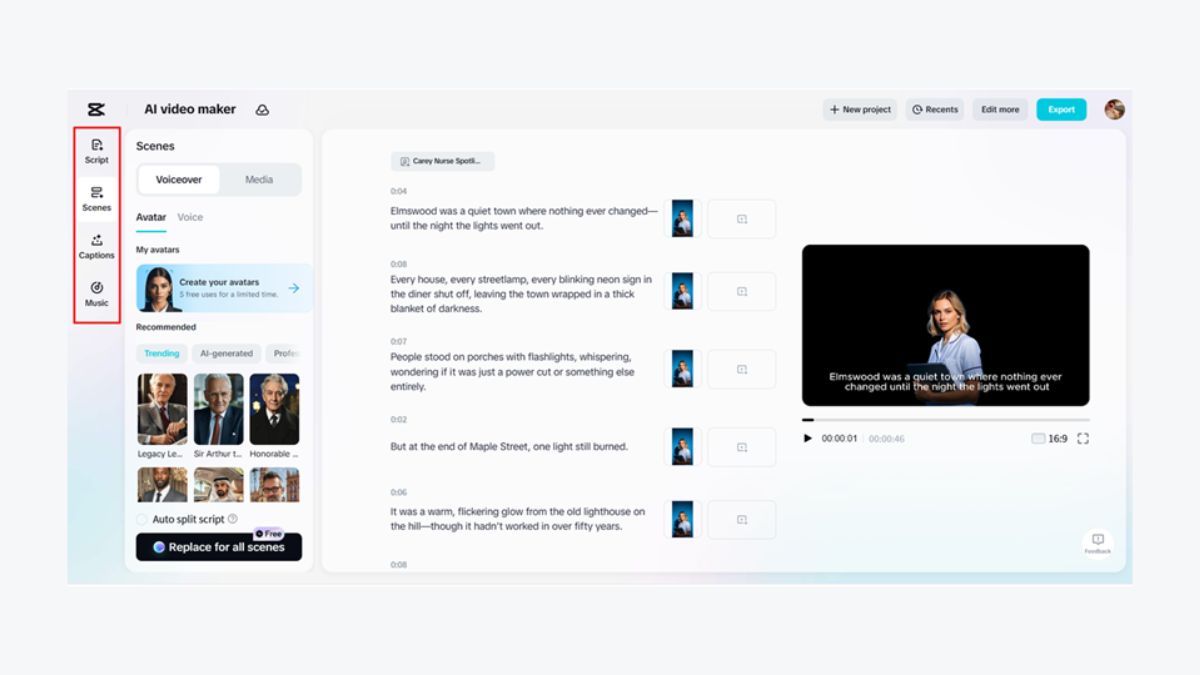
Step 3: Export or Edit More
Once you’re happy with the structure, preview your video. If it’s ready, click “Export” and adjust your settings to save it in the best quality. If not, click “Edit more” to enter the CapCut Web’s main video editor and polish visuals, adjust tone, or add transitions. This gives you the freedom to refine every detail until it matches your vision.
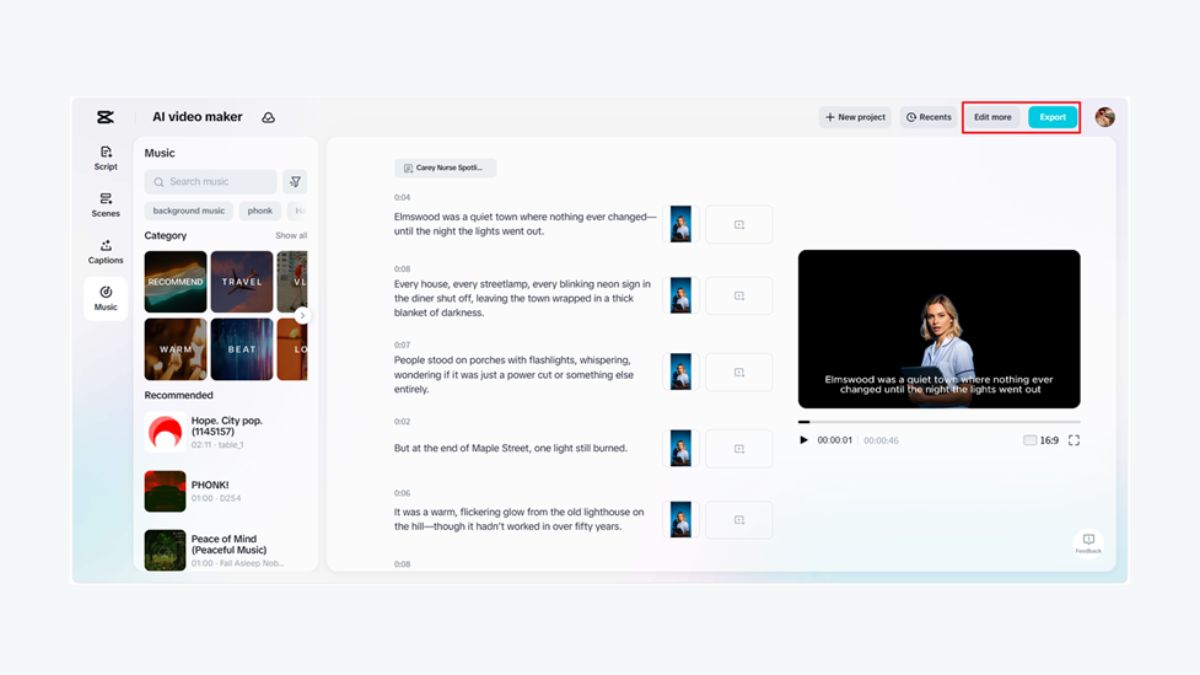
Showcasing Your Team and Culture Virtually
Use avatars for introductions or testimonial segments to create a futuristic and consistent look. Pair this with real team photos, short b-roll clips of events or meetings, and behind-the-scenes shots to add depth. Adjust tone and color grading to reflect your brand—whether that’s vibrant, minimalist, or corporate.
CapCut Web also supports auto-subtitles and visual effects. You can make content more accessible and more emotionally engaging. Use the AI caption generator to maintain clarity and style in every frame.
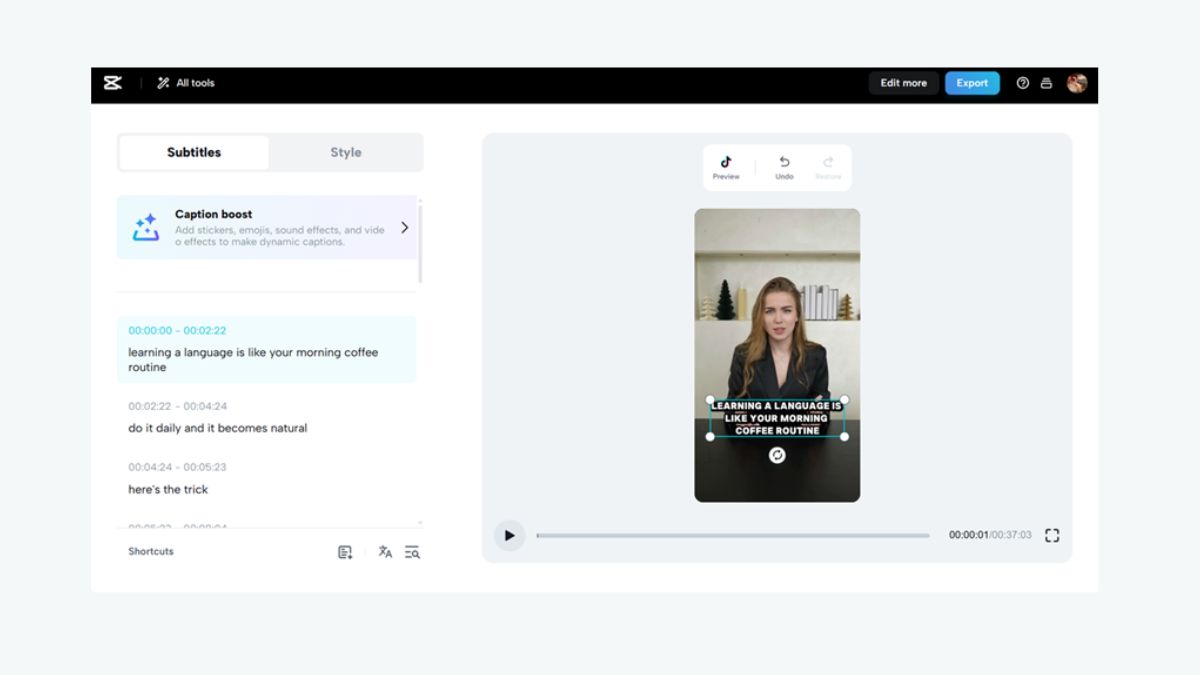
Optimizing Video for Job Boards and Social Channels
Tailor your video’s size and layout for platforms like LinkedIn, TikTok, or Instagram. Different channels call for different aspect ratios. Use CapCut Web’s built-in export settings to match them. Add clear CTAs such as “Apply Now” using on-screen text or visual elements that guide viewers.
Include royalty-free assets—animations, symbols, and music—to maintain legal safety and boost visual appeal. All of these assets are available within CapCut Web’s vast media library.
If you need voiceovers without recording anything, use the text to speech free feature within the platform. Pick a voice that fits your tone—professional, upbeat, or friendly—and keep it consistent across projects.
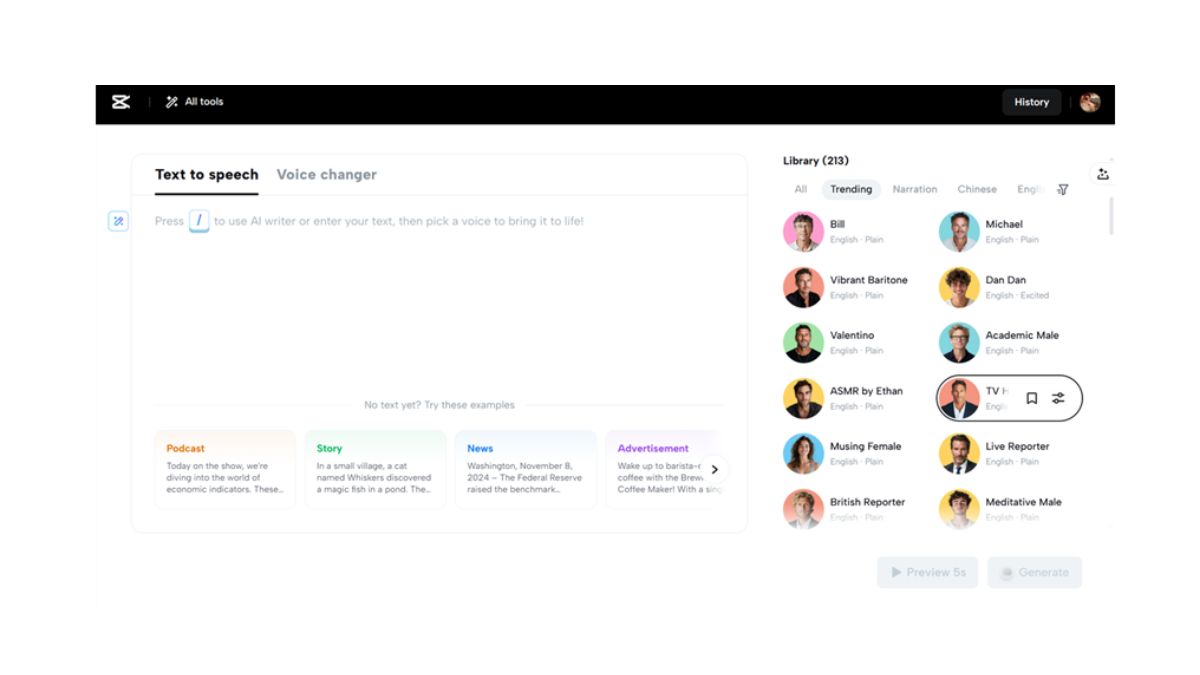 Tips to Keep Recruitment Videos Engaging
Tips to Keep Recruitment Videos Engaging
Keep it short. Recruitment clips perform best under 90 seconds. Start strong—grab attention in the first five seconds. Speak directly to candidate aspirations. Instead of “We’re hiring,” try “Imagine building the future with us.”
Structure your video like a story. Set a scene, present a problem (the role you’re hiring for), and offer the solution (joining your team). Let AI tools assist, but inject your company’s human touch.
Conclusion
Recruitment videos aren’t just nice to have—they’re a strategic advantage. They attract better talent, improve engagement, and communicate value instantly.
CapCut Web reduces the complexity of video creation. Its intuitive design lets hiring teams build professional content quickly, even without editing experience. With the power of AI, you can now transform job ads into compelling stories.
Start designing your recruitment clips today. Embrace the power of AI storytelling to hire smarter and faster.
-

 BLOG10 months ago
BLOG10 months agoSlothokiturbo.net: Exploring the World of Online Gaming and Community
-

 BLOG7 months ago
BLOG7 months agoLiteroticatags: Exploring the World of Erotica and Its Online Community
-

 BLOG12 months ago
BLOG12 months agoErothtos: Understanding Its Role in Today’s World 2025
-

 BLOG12 months ago
BLOG12 months agoWatchmenontheall Calvin: An Exploration of Themes, Characters, and Significance
-

 BLOG12 months ago
BLOG12 months agoLeah Gettens: Everything You Need To Know
-

 BLOG11 months ago
BLOG11 months agoUse 1.5f8-p1uzt – A Comprehensive Guide!
-

 TECH12 months ago
TECH12 months agoMansrufer: Pioneering Progress in Technology
-

 FASHION7 months ago
FASHION7 months agoAchieve the Perfect Beard with Black Male Beard Products
